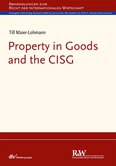II. Outline of the study
11
The second chapter provides the necessary groundwork for the following chapters, including remarks on the terminology (property, ownership, and title), the relevance of the legal history of unified sales law, the use of comparative law pre- and post-unification, and the conflict of law rules on property in the goods in litigation and arbitration. Moreover, different notions of property under national laws are illustrated: Is property a relative or absolute notion under national law, and are there national laws that do not contain any concept or one lump concept of ownership at all?
12
Turning to the CISG, one could be inclined to start with the exclusion of the effect the contract has on the property in the goods from the scope of the Convention under Article 4, sentence 2(b) of the CISG. Yet, to better understand the exclusion and what “property” under the CISG refers to, this work starts with the only other section of the CISG that mentions “property in the goods”. Article 30 obliges the seller to transfer the property in the goods. This obligation forms the basis of the third chapter: The seller’s obligation to transfer the property and the respective notion of “property” under certain national laws (Switzerland, France, England, Germany) are analyzed historically and comparatively to explain the later development of said obligation within unified sales law. A crucial question in this context is whether “property” under the CISG can and should be interpreted as an autonomous con
13
Since Article 30 of the CISG and the obligation to transfer the property in the goods are often taken to form part of the definition of a sales contract, the fourth chapter addresses the relevance of “property” in characterizing a sales contract under Article 1(1) of the CISG.
14
The fifth chapter concerns the surprisingly divergent understanding of the seller’s claim for the purchase price in civil and common law jurisdictions. Since this claim is almost inextricably interwoven with the transfer of property in many common law jurisdictions (for example, in the UK, section 49(1) of the Sale of Goods Act 1979), this historical connection is reviewed. The CISG has not copied this connection directly, and Article 62 of the CISG contains a broadly worded remedy of the buyer to claim the purchase price. However, it has been subject to debate whether the restrictions of the action for the purchase price and the relevance of the transfer of property resurface due to Article 28 of the CISG. The latter provision allows courts to refuse specific performance if they would do so under their respective national law.
15
While chapters three to five address the impact of property and its transfer on the CISG, chapters six to eight examine the converse: What impact does the CISG have on the property in the goods? The sixth chapter addresses the exclusion of the transfer of property under Article 4, sentence 2(b) of the CISG. This sequence of chapters allows an assessment of whether the proposed definition of “property” under Article 30 of the CISG developed in the third chapter can also be applied under Article 4. Moreover, this sequence allows assessing whether the decision not to regulate the effects of the CISG on property was sensible against the background of the remaining relevance of property under the CISG discovered in the foregoing chapters.
16
The relationship between claims or remedies based on property under national law and the CISG is discussed in the seventh chapter. It is important to note that national laws approach such claims based on property differently. Some allow parties to sue for possession of the very goods in question (vindication), while others generally allow the debtor to compensate the creditor in damages. It is questionable whether the CISG preempts such claims based on national law.
17
Finally, the eighth chapter is concerned with property in the goods and insolvency of one of the contractual parties. Generally, property is highly


